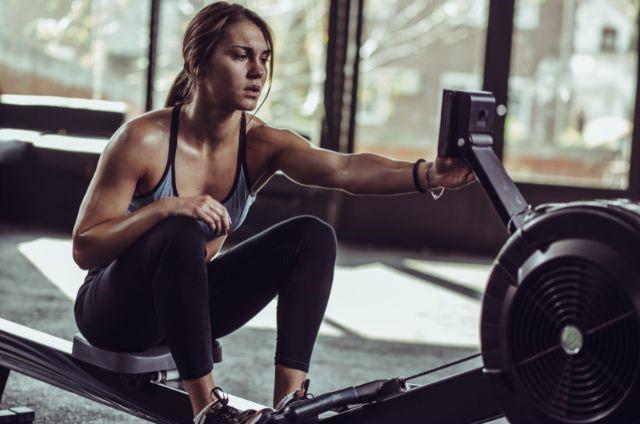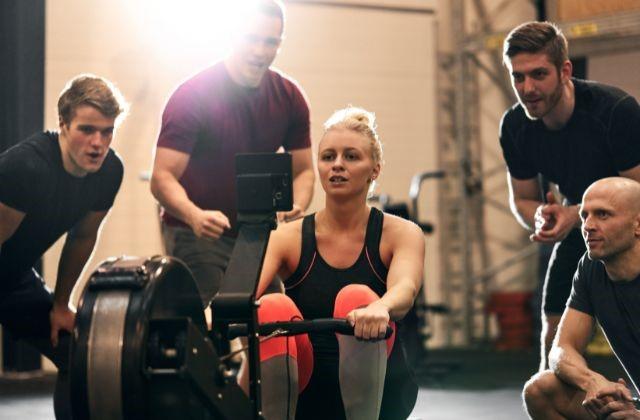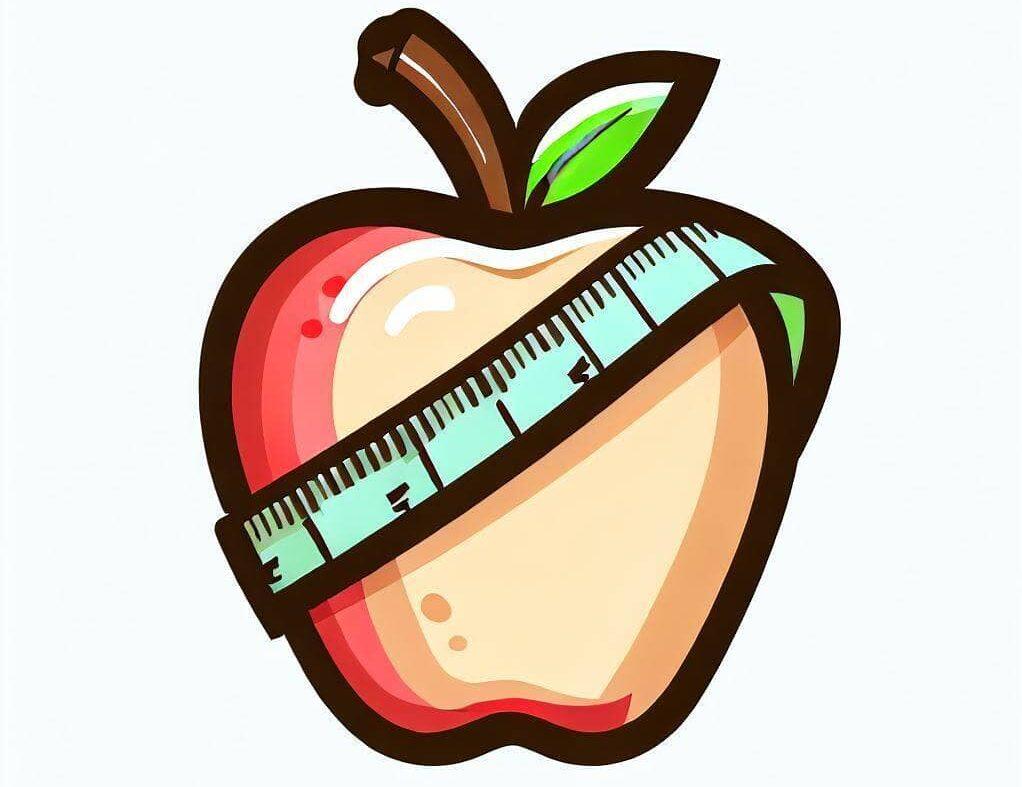Are Rowing Machines Good for Weight Loss?
This post may contain affiliate links which means I may receive a commission for purchases made through links at no extra cost to you. See my disclosure policy for more information.

“Are rowing machines good for weight loss?” Yes, rowing machines are good for weight loss. They provide a full-body workout that can burn a significant number of calories, increase metabolism, and build muscle, all of which contribute to weight loss when combined with a balanced diet and consistent exercise routine. Let’s do a deep dive into this.
Benefits of Rowing for Weight Loss
Let’s explore the inherent advantages of rowing as a tool for losing weight.
Caloric Burn
When you engage in any physical activity, your body uses energy, and that energy is counted in calories.
Rowing is particularly effective in this regard because it requires both aerobic (cardiovascular) and anaerobic (muscle-strengthening) effort.
The body primarily uses glucose from carbohydrates for quick energy during high-intensity workouts. But as this reserve diminishes, the body begins to tap into stored fat for fuel.
The dual action of pushing with the legs and pulling with the arms means that multiple large muscle groups are working simultaneously.
This cooperative muscle engagement requires more energy, leading to a higher caloric burn.
According to some estimates, an intense rowing session can burn anywhere from 400 to 800+ calories an hour, depending on factors like weight, age, and intensity.
Also read: Best Energy Drink For Weight Loss
Full Body Workout
For weight loss, exercises that engage multiple muscle groups simultaneously are more effective than isolated exercises.
When more muscles are active, more oxygen is required, leading to an increase in the heart rate and respiratory rate, which in turn burns more calories.
According to American Fitness Professionals & Associates, with every stroke, you’re engaging about 65-75% leg work and 25-35% upper body work.
This includes the quads, hamstrings, glutes, back, core, shoulders, and arms. The leg push engages the lower body, the hinge and pulls engage the back and arms, and throughout the motion, the core is activated for stability.
This holistic muscle engagement not only burns calories but also helps tone and strengthen the entire body.
Low-Impact Exercise
High-impact exercises, like running or jumping, can be hard on the joints due to the force exerted on them with each movement.
Over time, this can lead to injuries or exacerbate existing joint issues.
Low-impact exercises, on the other hand, minimize this risk as they exert less force on the joints.
The seated nature of rowing means there’s no jarring impact on the knees, hips, or ankles.
The smooth, gliding motion of a rower ensures that the joints are cushioned from heavy impact, making it an excellent choice for those with joint concerns or for those looking for an effective workout without the wear and tear on joints.
The Synergy of Cardio and Strength Training
Cardiovascular exercises elevate the heart rate, improving heart health and increasing calorie burn.
Strength training, meanwhile, focuses on muscle building, which can elevate your basal metabolic rate (the rate at which your body burns calories at rest).
An elevated BMR means you’ll burn more calories throughout the day, not just during your workout.
A rowing session incorporates both cardiovascular and strength elements. The continuous motion elevates your heart rate, providing the cardio component.
At the same time, the resistance (whether from the machine’s settings or water, depending on the type of rower) ensures that the muscles get a robust workout, contributing to the strength training aspect.
This dual benefit means you’re getting the advantages of both cardio and strength training in one go, making rowing an efficient weight-loss exercise.
Also read: Are Chicken and Rice Good For Weight Loss?
How to Maximize Weight Loss with a Rowing Machine

Elevate your calorie burn and efficiency with these tailored rowing strategies.
Incorporating HIIT (High-Intensity Interval Training)
HIIT involves short bursts of intense exercise followed by low-intensity recovery periods. This form of training can elevate your heart rate quickly, leading to an increased calorie burn in a shorter amount of time.
Furthermore, HIIT workouts can create an afterburn effect, scientifically known as excess post-exercise oxygen consumption (EPOC).
This means the body continues to burn calories at an elevated rate even after the workout is over.
Consistency is Key
Weight loss is often a result of a sustained calorie deficit over time. Consistent physical activity ensures that the body is continually in an energy expenditure mode, contributing to this deficit.
Additionally, consistent workouts help build muscle, which in turn boosts the basal metabolic rate (BMR).
By integrating rowing into your weekly workout routine—aiming for at least three times a week—you’ll ensure that you’re frequently burning calories and building muscle, pushing you closer to your weight loss goals.
Focus on Proper Form and Technique
Proper form ensures that the right muscle groups are engaged, maximizing the workout’s efficiency. Incorrect technique, on the other hand, can lead to ineffective workouts and potential injuries.
The right form ensures that energy is not wasted and that each stroke is productive in terms of muscle engagement and calorie burn.
Ensure that your strokes are fluid. Start with the “catch” (knees bent, arms extended), push with your legs, engage your core, and follow with a pull using your arms.
On the return, it should be arms first, then hinge at the hips, and finally bend the knees.
Training initially with a coach or using online tutorials can greatly help in mastering the technique.
Gradually Increase Resistance
As with all strength training, progressive overload is vital. This principle involves gradually increasing the resistance or weight to challenge the muscles and stimulate growth and strengthening.
With increased muscle mass, the body’s metabolism can speed up, aiding in weight loss.
Rowing machines typically come with adjustable resistance settings. Start at a comfortable level, and as you get stronger and more proficient, incrementally increase the resistance.
This ensures your muscles continually adapt and grow, leading to increased caloric expenditure.
Supplement with Strength Training
While rowing is a compound exercise that involves various muscles, targeted strength training can further enhance muscle development.
As previously mentioned, more muscle can elevate BMR, allowing for more passive calorie burn throughout the day.
After a rowing session, consider integrating weight lifting or bodyweight exercises targeting specific muscles. This can include squats, lunges, push-ups, or resistance band exercises.
Also read: Are Protein Pancakes Good For Weight Loss?
Common Misconceptions About Rowing and Weight Loss
Addressing prevalent myths and misunderstandings about the impact of rowing on weight loss.
Spot Reduction is Achievable with Rowing
Spot reduction refers to the idea that exercising a particular body part will result in fat loss specifically from that area.
Unfortunately, the human body doesn’t work this way. Fat loss occurs systemically, meaning it’s lost throughout the body, not just from the area you’re working on.
While rowing does engage major muscle groups, including the legs, back, arms, and core, it won’t directly “melt” fat off these areas alone. Instead, rowing can help in overall fat reduction and muscle toning.
The Harder You Row, The More Fat You Burn
While intensity plays a role in calorie expenditure, it doesn’t directly equate to fat burn. Very high-intensity workouts tend to burn glucose more than fat.
Lower intensity, sustained workouts—often termed “fat-burning zones”—utilize more fat as fuel. However, high-intensity workouts can lead to a significant afterburn or EPOC, which can enhance calorie burn post-exercise.
A balanced approach is key. Incorporating both high-intensity intervals and steady-paced, longer rowing sessions can provide a comprehensive fat-burning regimen.
Rowing Machines Only Target Your Upper Body
Certain exercises do target specific areas more predominantly. However, rowing is a full-body workout, requiring power from both upper and lower body components.
The drive phase of a rowing stroke primarily utilizes the legs, which are responsible for the majority of power generation.
The back, shoulders, and arms play a secondary (yet crucial) role. Anyone who’s rowed intensely will testify to the burn felt in the thighs and glutes!
Caloric Burn from Rowing is the Same for Everyone
Caloric expenditure during exercise is influenced by several factors, including age, gender, body weight, muscle mass, and workout intensity.
Two individuals rowing side by side at the same pace might burn a different number of calories based on their unique physiologies. It’s essential to use general figures as a guideline to understand individual variations.
Rowing Alone is Sufficient for Weight Loss
There are many aspects to weight loss. It’s not just about exercise but also involves diet, sleep, hydration, stress management, and more. While exercise increases caloric expenditure, diet plays a major role in caloric intake.
Rowing is an effective tool in the weight loss arsenal, but it should be complemented by a balanced diet, adequate rest, and other lifestyle considerations to see the best results.
Also read: Best Sleeping Position for Weight Loss
How to Row Properly?
Proper technique is essential when rowing to maximize efficiency, prevent injuries, and ensure the most effective workout. Here’s a step-by-step breakdown of the rowing process:
1. Starting Position (The Catch)
- Sit on the rowing machine with your feet securely fastened to the footplates.
- Keep your knees bent and directly over your ankles.
- Lean slightly forward from the hips, maintaining a straight back.
- Grip the handle with an overhand grasp, hands shoulder-width apart.
2. Engage the Legs
- Begin by pushing off with your legs. This leg drive contributes to the majority of your power when rowing.
- Ensure your arms remain straight, and your back stays at the same forward angle.
3. Hinge at the Hips
- Once your legs are nearly fully extended, hinge back at the hips.
- Lean back to an angle of about 45 degrees, ensuring you’re using your core muscles for stability.
4. Pull the Handle
- With your back leaned and legs extended, pull the handle towards your lower ribs.
- Keep your elbows pointing slightly downwards and close to your sides. Avoid flaring them outwards.
5. End of the Stroke (The Finish)
- At this point, your legs should be fully extended, your back leaned back, and the handle held close to the body.
- Ensure a straight line from your head down to your tailbone, and avoid overarching or slumping your back.
6. Returning (The Recovery)
- Begin the recovery by extending your arms back out in front of you.
- Once the handle has cleared your knees, bend your knees to start sliding the seat forward.
7. Return to the Starting Position
- Continue sliding forward on the seat until you’re back at the starting position.
- The handle should be extended forward, and your shins should be close to vertical.
8. Maintain a Smooth Rhythm
- Establish a steady rhythm between the drive (pushing off and pulling the handle) and the recovery (returning to the start).
- Ensure a fluid motion, avoiding any jerky movements.
9. Breathing Pattern
- Inhale during the recovery phase as you slide forward.
- Exhale as you drive back, using the force of your legs and pulling the handle.
10. Monitor Your Posture
- Throughout each phase, ensure your spine remains neutral, shoulders are relaxed, and head is aligned with your spine.
- Avoid rounding your back or tensing up your shoulders.
Sample Rowing Workouts
Whether you’re a beginner or an experienced rower, these sample workouts can offer variety, challenge, and specificity to your training routine. Adjust as necessary based on your fitness level and goals.
1. Beginner’s Introduction to Rowing
As a newcomer to rowing, the primary focus should be on mastering the correct technique and becoming familiar with the machine’s rhythm. This 22-minute beginner-friendly session aims to introduce you to the rowing motion without overwhelming you.
By maintaining a consistent, moderate rate, you’ll lay down the foundation for more advanced workouts in the future.
Most rowing machines will showcase the strokes per minute, assisting you in maintaining your rhythm.
Starting with this routine, practice it 2-3 days a week, progressing as you become more comfortable and confident.
| Specifications | Time (minutes) | Rate (strokes per minute) |
| Warmup | 5 | 18 |
| Main workout | 12 | 22 |
| Cooldown | 5 | 18 |
| Total | 22 minutes | 466 strokes |
2. Cardio Endurance Session
Boosting cardiovascular endurance is vital for any fitness journey. This 42-minute workout is crafted to build stamina by maintaining a steady pace throughout.
By emphasizing duration over speed, you’re training your heart and muscles to work efficiently over extended periods.
As with all workouts, familiarize yourself with the strokes-per-minute metric on your rower’s display.
Incorporate this endurance-focused routine twice a week, and watch as your stamina noticeably improves over time.
| Specifications | Time (minutes) | Rate (strokes per minute) |
| Warmup | 7 | 20 |
| Main workout | 30 | 24 |
| Cooldown | 5 | 20 |
| Total | 42 minutes | 1016 strokes |
3. Interval Training for Fat Burn
Intermittent bursts of high-intensity rowing interspersed with recovery periods define this interval-based workout.
This 30-minute session is excellent for maximizing calorie burn in a short timeframe. The change in intensity helps boost metabolism, which can lead to increased fat loss.
Your rowing machine’s display will assist you in keeping track of your strokes per minute during each intense phase.
For optimal results, aim to include this workout in your routine 2-3 times a week, ensuring at least a day’s rest in between to allow for muscle recovery.
| Specifications | Time (minutes) | Rate (strokes per minute) |
| Warmup | 5 | 20 |
| Main workout | 20 (10 sets of 1 min on/1 min off) | 26-28 |
| Cooldown | 5 | 20 |
| Total | 30 minutes | 720 strokes |
4. Power Strokes for Muscle Strength
Aiming to enhance muscle strength and power, this 28-minute workout integrates powerful strokes with periods of rest.
This approach not only builds muscle but also aids in developing explosive strength, which can benefit other areas of fitness. It’s essential to maintain proper form during each powerful stroke to avoid injuries.
Incorporate this strength-focused regimen into your weekly schedule 2 times, ensuring you’re adequately warmed up before each session.
| Specifications | Time (minutes) | Rate (strokes per minute) |
| Warmup | 5 | 20 |
| Main workout | 18 (8 sets of 10 strokes + rest) | 28-30 |
| Cooldown | 5 | 20 |
| Total | 28 minutes | 656 strokes |
5. Pyramid Intervals for Stamina and Endurance
Combining the best of endurance and interval training, this pyramid structure gradually increases the rowing intensity and then brings it back down.
This 39-minute workout is tailored to challenge both your stamina and adaptability. By varying the intensity, your body learns to efficiently switch between energy systems, making you a more versatile athlete.
Given the challenging nature of this session, aim for 1-2 times a week, making sure you’re adequately rested before each attempt.
| Specifications | Time (minutes) | Rate (strokes per minute) |
| Warmup | 7 | 20 |
| Main workout | 25 (Pyramid structure) | Varies (22-28) |
| Cooldown | 7 | 20 |
| Total | 39 minutes | 936 strokes |
Conclusion
In the grand scheme of things, rowing machines can be an excellent tool in your weight loss journey.
They offer a full-body, low-impact workout that can help you burn calories. But remember, it’s one piece of the puzzle.
A balanced diet, consistency, and perhaps a sprinkle of determination go a long way.
Also read: Is Chocolate Milk Good For Weight Loss?
FAQ
Is rowing a good exercise for weight loss?
Yes, rowing is a good exercise for weight loss because it offers a full-body workout, burning a significant number of calories and engaging major muscle groups.
How much weight can you lose rowing?
The weight you can lose rowing depends on factors like your diet, workout intensity, and frequency. On average, with consistent rowing and a balanced diet, you can lose 1-2 pounds a week.
How long on rowing machine to lose weight?
Spending 30-45 minutes on a rowing machine, 3-5 times a week, combined with a balanced diet, can lead to noticeable weight loss over several weeks.
How many calories does rowing burn?
Rowing can burn between 400-800 calories per hour, depending on the intensity, weight, and metabolism.
Rowing machine how long to see results?
With consistent workouts and a balanced diet, many individuals begin to see results, such as increased muscle tone and weight loss, in as little as 3-6 weeks.
Is rowing a good exercise?
Yes, rowing is a good exercise because it offers a cardiovascular workout while also strengthening various muscle groups, improving stamina, and promoting overall fitness.
This post may contain affiliate links which means I may receive a commission for purchases made through links at no extra cost to you. See my disclosure policy for more information.
Rahul is a professional nutritionist certified by the International Sports Sciences Association (ISSA) and a personal trainer certified through the American Council of Exercise (ACE). He has a special interest in the science of nutrition and how it can impact the body.
